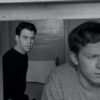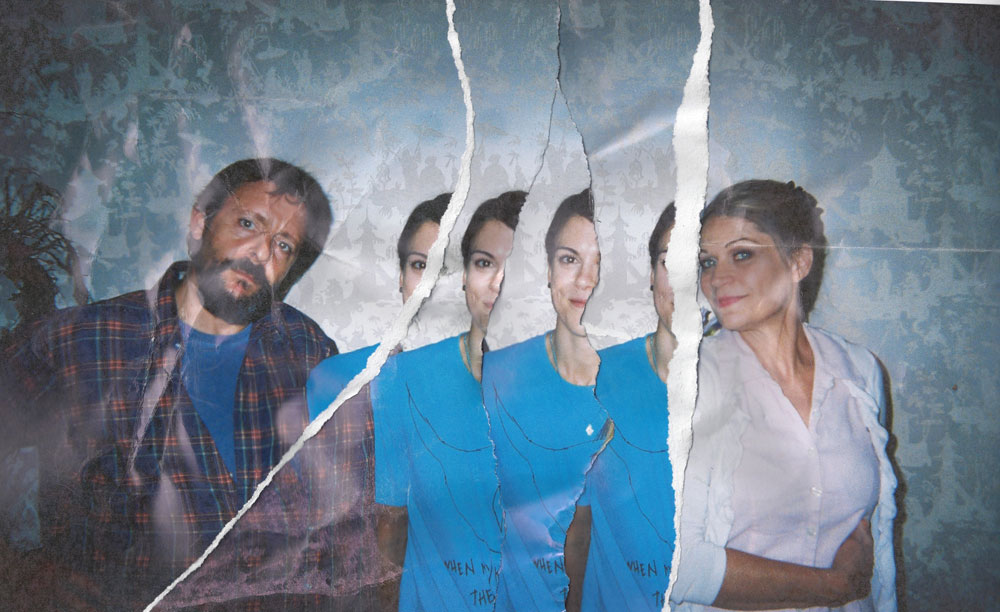When attempting to get inside the head of Lissa (Lindsey Shaw), a 20-year-old woman banging around the city limits of her home in rural Pennsylvania trying to break through, writer/director Jeremy Phillips knew it would take far more than just to point and shoot a camera in his directorial debut “1/1.” Potentially on the verge of motherhood, Lissa’s mind runs in any different number of directions, towards her fraught relationship with her own mother (Dendrie Taylor), the youthful indiscretions that have delayed thinking of the future and the fate that awaited her father (Judd Nelson) when the feeling of being trapped by similar circumstances led to his untimely death – memories and thoughts that couldn’t be expressed simply in a linear fashion as the collision between them can bring out new meaning and one mode of experience wouldn’t do.
So Phillips created a layered approach that would come to involve three sets of cameras – a documentary unit, a more traditional set-up for the dramatic narrative, and a still photography unit so the mental fragmentation could be expressed visually, a process that added up to three times the material of your normal production. Yet “1/1” emerges as a fluid experience, aided by an ethereal score from the band Liars, that pairs the desperation of small-town life with the exhilaration of seeing something new, a feeling that one not only picks up in the eyes of Shaw’s Lissa, but how Phillips makes the film’s jagged edges fit together so cleanly. As the film finds its way out into the world with a recent release on VOD, the director and star of “1/1” spoke about how Shaw wasn’t only stepping onto a set to make a film, but into Phillips’ old life and how the intimacy of the shoot contributed to a personal final product.
Jeremy Phillips: I moved out to California to go to film school and you have to go back for whatever reason to your hometown, just having a different perspective on it. It was interesting to see your world from the outside and [that] made me interested in a way I never was, so I started doing tons of research about the area – about the population and government reports and from there, I built the world of it – this kind of decaying space, and then ultimately, it was so strange when we met Lindsey in that space, visualizing what someone would be like there. Everything is very specific to her. Her coat is handmade, I picked out the fabric myself. The boots were handmade. A lot of it came from [meeting her].
Lindsey Shaw: I read the script and truly, I couldn’t get through two or three pages of it [without] breaking down and crying. I just connected to what was being written. It hit me in my heartspace. It really wasn’t a mental experience for me. It really was a lot of feeling and it’s written like a poem, the whole thing, so I just never had an experience like that. Then I went into meet [Jeremy] and I thought I made a total buffoon of myself, but…
Jeremy Phillips: She didn’t. [laughs] She came to our audition and she was genius. Straight up like made the character richer and I mean this with all sincerity, because a lot of people say bullshit in these things, but the actual truth is Lindsey Shaw is as much a part of this film as I am.
Lindsey Shaw: Oh, no…
Jeremy Phillips: It was just really great.
Lindsey Shaw: I am humbled and moved that [Jeremy] would ever say anything like that because I’m aware of, on a small scale, what he put into it. We just saw it together. We would have these conversations after filming where we’d ease each other about [what we’d shot] because it was a scary process to go out there and give so much of yourself and I felt like we were both doing that. We both just related to each other really well. We were good partners to get through it.
So many of the scenes are shot seemingly in isolation – is that a different dynamic for you to not have anyone but the crew to react off of in a scene?
Lindsey Shaw: That’s why I had to come to [Jeremy] so much after filming, to be like, “Yo, was that completely off-base?” Because you don’t know if you’re getting so deep into your ego or if this is true or what you’re doing is good. It’s all coming from inside of you, so it’s hard to find your barometer. It’s easy to float away from that kind of a feeling, but you had to stay grounded in those feelings and that was hard and uncomfortable. But I just felt so close to the crew by the end because we just went through such an intimate experience over these three weeks. Way more intimate than things that I have been used to.
Jeremy Phillips: You bought someone glasses! This crew was fantastic and really passionate about working on it and [Lindsey] became really close with certain…
Lindsey Shaw: Yeah, Dinair, I love you! He needed new glasses, for realized. [laughs] These people just touched my heart completely and that’s what we needed to make this film.
Jeremy Phillips: And I hope some people from Pittsburgh hear this because we love you.
Did you actually shoot in the town you grew up in?
Jeremy Phillips: Yeah, the doctor’s office is an actual doctor’s office. We asked someone to move out of her apartment so we could redesign it, and she moved somewhere else. At the end, that’s my mom’s house – and don’t ever shoot in your mom’s house and then have to sleep there because your mind will get all fucked up. [laughs] It was nuts. I couldn’t tell if I was dreaming and if I was shooting…
Lindsey Shaw: Dude, the experience that you had.
Jeremy Phillips: It was so crazy.
Lindsey Shaw: Several lifetimes have been worked out on this film, I feel.

Jeremy Phillips: I didn’t really know them. But yes, they were real people excluding Lindsey and [the actress who played] her mother Dendrie. So what we did was we had about 15 people and divided the questions into work, birth and love and had them talk about each subject. I will say that if you weren’t interesting, you didn’t make [the cut] and let’s say my mom’s not interesting.
Lindsey Shaw: This is so harsh. [laughs]
What’s it like entering this when it’s someone else’s life as much if not more than a film set?
Lindsey Shaw: Not half as intense as it would’ve been to be in [Jeremy’s] shoes. It was so familial and that’s what helped all of this vulnerability come out. In the end, this is such a film about family connection, and how you get there, so for me personally, it was beautiful to be around a family atmosphere behind the scenes because there’s nothing more comforting than having a good momma around.
Jeremy Phillips: Except when she walks into your shot. True story.
Was that a hazard on this set?
Jeremy Phillips: It was. A bunch of times, I was like, “Mom, what the fuck are you doing?” [laughs]
Lindsey Shaw: She is trying to make things perfect for you!
Jeremy Phillips: [In general] it was a hard shoot. We didn’t have a lot of money and there were a lot of emotional scenes and a lot of complex camerawork. We had three units – the photography unit, the documentary unit and the main thing – [going at the same time] and the actors would have to bounce around between the three. It was hard from our side and Lindsey can speak for herself, but it was emotionally taxing.
Lindsey Shaw: Yeah, the whole film is like a dark tunnel until you get to the end, so you just had to live there and be there.
I understand the visual approach of the film was pretty explicitly laid out in the script – did that help?
Lindsey Shaw: It was still pretty hard to even visualize at that point, but it just felt like its own experience from the beginning. You’d be shooting so many different things – it’d be a picture, then it’d be moving and then it’d be a slower-moving picture, all of these different ways that would capture how you feel.
Jeremy Phillips: Also, I was working with three shotlists [for the various cameras] – the HD shot, the digital and then the Super 8 and then the still photography and find how they signify different things. For the cinematographer and I, our favorite parts were just tossing the Super 8 camera back and forth and messing around with it, but confusing to the actors as I’d learn later because they’d be like, what the fuck is happening? [laughs] But the general idea of the film is that it’s a coming-of-age story and as Lissa matures, so does the visual language of the film. It goes through this raw, jump-cutting, jagged [look] to a more polished, classical style at the end, so that was all tracked throughout the script. A lot of the scenes would have a little description, like the party scene was in black and white [with] really deep blacks and really hot whites, and we’d do these storyboards [where it’d say] this scene is shot on Polaroids, this scene is shot on 35mm stills.

Jeremy Phillips: All of it was developed before. The paintings that you’ll see in Lissa’s apartment were made specifically for her and she’s reading the book “Infinite Jest” by David Foster Wallace, so some of the paintings refer to that. Of course, there’s the family tree that was built out with all these animals and like I said, I made a lot of her T-shirts that are drawn on and then we got the others that were silk-screened. Every piece we tried to make individual because it’s real easy to go into a generic idea of a rebel character, so it was all very planned out ahead of time – her earrings, how much nail polish she had, everything.
Was there a detail for that could unlock who this person was?
Lindsey Shaw: A huge part that let me know exactly who this character was were those scenes where she’d be wandering around her apartment, with a 40, sometimes reading, always with a cigarette and doing some sort of random arts and crafts. I completely knew exactly who she was, just from right there [because] I’ve definitely experienced times like that in my life where you just wander around lost in your own apartment. I did a lot of driving for a time in my life because that was the only thing that soothed me, so just the constant wandering. Also, all the cigarettes. [laughs] There’s nothing to do when you can’t get out of your head – you need that oral fixation, you need the physical movement of the cigarette. Honestly, that’s why my voice is a little bit hoarse [in the film]. Not only was it freezing out, but we were walking around the in the cold chain-smoking.
Jeremy Phillips: And I’d never heard her say this, but those moments to me were probably the genesis of the character and understanding who she was. It’s very personal to me, because I used to wander around and drink 40s a lot, so if there’s an autobiographical element, it’s in those scenes as well.

Jeremy Phillips: Yeah, I’m a huge fan of the band and I like to think that their DNA was in the film. This album “WIXIW” came out when I was writing and I listened to it over and over again and named [storyboard] panels after their songs or had little references. It was such an honor to meet them and to collaborate with them and they gave us a lot of the score early so what we could make a picture edit based on the music and sometimes they’d make a song edit [based on the footage we shared with them], but it was a give and take over a few months, trying to place it all. It was interesting too because we had a temp track that was nowhere near what they gave us and that really changed the movie dramatically.
With something this stylized, was there room to change during editing or were you really locked into things?
Jeremy Phillips: Yeah, we did lose a couple scenes and we moved a couple things around. It was really locked in, but we had so much material – 40 hours of RED footage, 7000 35mm still photographs and 50 rolls of Super 8 film, so it was just like finding nice cuts. Even though it was all planned out, it still took a long time. Two editors and me in a room for eight months. It was…
Lindsey Shaw: This is why when [Jeremy’s] trying to be like, “This is each our film,” I’m like [throws hands up in the air], “What?”
Jeremy Phillips: It was rough. And it smelled. Three dudes in a room after eight months. [laughs]





